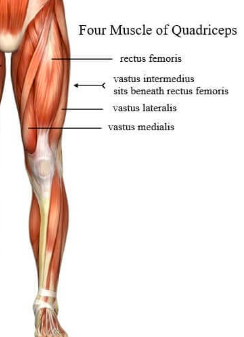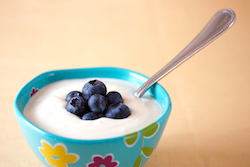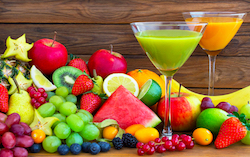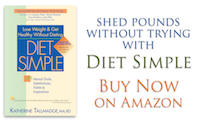Spring Training: Strength Train for Knee Pain
- At March 21, 2019
- By Katherine
- In Articles, News
 0
0
 Tree Pose. Ommmmmmmm…
Tree Pose. Ommmmmmmm…
I have knee issues like about everyone else I know. In fact, “about 60 million Americans have knee osteoarthritis and this number will increase by 50% over the next decade,” according to The Journal of Injury, Function, and Rehabilitation. I started feeling little twinges by my early 30’s. Perhaps being a gymnast and a dancer growing up led to early symptoms. No matter, working with physical therapists and trainers over the years averted any serious pain – until recently.
 Three years ago, a torn meniscus required arthroscopic surgery, but my knee pain is back. After some research, I found a review of studies in the journal, BMC Musculoskeletal Disorders, and I learned that certain knee arthroscopic surgery is controversial because apparently, it can hasten knee degeneration. That can lead to the need for knee replacement within just a couple of years. So I can’t help wondering: Should I have undergone the arthroscopic surgery to begin with? There are really no answers. And I can’t look back now.
Three years ago, a torn meniscus required arthroscopic surgery, but my knee pain is back. After some research, I found a review of studies in the journal, BMC Musculoskeletal Disorders, and I learned that certain knee arthroscopic surgery is controversial because apparently, it can hasten knee degeneration. That can lead to the need for knee replacement within just a couple of years. So I can’t help wondering: Should I have undergone the arthroscopic surgery to begin with? There are really no answers. And I can’t look back now.
But I’m feeling hopeful these days. Lots of interesting research is showing that exercising certain muscles with heavier weights, using fewer repetitions (meaning you exhaust your muscle within 8 to 12 reps) can successfully decrease knee pain while increasing function, and that includes longer and stronger walking.
I’m especially convinced about these recommendations because a body of evidence is building that “power training” with heavy weights is most effective at building muscle in older people. That’s because it improves the functioning of the nerves that power muscle, according to a study conducted by the Norwegian University of Science and Technology. The degradation of these nerves is a major cause of muscle impairment in older people, causing disability and loss of independence.
“Improvements in symptoms and function are directly related to exercise intensity and that higher intensity (if maintained over time) would sustain muscle strength and preserve functional abilities,” according to the knee arthritis study. The study continued to state that even with more severe knee arthritis, intense strength training enhances postoperative recovery if knee replacement is necessary.
Quadricep strength is particularly important.
To that end, I’m working with a physical therapist and trainer (periodically), and have invested in (used) weight machines (Craig’s list). I’m exercise biking, and do mat pilates from a YouTube video. It’s amazing how much more easily – and with significantly less pain – I can walk after I exercise.
I urge you to do the same!
Vaccines are Safe!
- At March 08, 2019
- By Katherine
- In Articles, News
 0
0

Vaccines are Safe Based on Decades of Sound Scientific Research, According The National Academies of Sciences, Engineering and Medicine
“The current measles outbreaks in the United States and elsewhere are being fueled by misinformation about the safety of vaccines,” according to warnings issued recently from the Presidents of the National Academies of Sciences, Engineering and Medicine.
To help counter such misinformation, the Academies created a website that provides clear, concise, and evidence-based answers to questions about vaccine safety and other commonly asked questions about health and science as identified through our partnership with Google.
The evidence base includes a number of our studies examining vaccine access, safety, scheduling, and possible side effects. Our work has validated that the science is clear – vaccines are extremely safe, continued the warning from the Academies Presidents.
Given our shared congressional mandate to advise the nation, we are compelled to draw attention to these facts in order to inform better decision-making at a time when it is urgently needed to protect the health of communities in our country and around the world.
Furthermore, we call on our professional colleagues everywhere to share these facts as widely as possible, they added.
To Curb Cravings, Eat a Sweet at Every Meal
- At March 01, 2019
- By Katherine
- In Articles, News
 0
0
My client, Debbie, said sweet cravings were destroying her health and her weight loss attempts. She was “eating practically a box of chocolates every day” and couldn’t stop. And while chocolate fits into a healthy diet – I prescribe daily chocolate for my clients who need to gain weight – the amount she was eating was not helping her high cholesterol, her fatty liver, and was causing her weight to soar higher and higher.
What seemed like an impossible problem was a cinch to fix. All we did was add sweet foods to her routine. You see, your body craves a variety of flavors, textures, colors and shapes, preferably in each meal, to feel satisfied. If one of those flavors, such as sweet, is missing from your meal, you are less likely to feel satisfied and you will crave that missing flavor. Pay attention to your next large savory meal. Even if you are no longer hungry, you will probably crave sweets afterwards. If, on the other hand, you include fruit as a part of your meal, you will crave fewer sweets, which is something I advise in my book, Diet Simple.
Evolution created our drive for food variety, as it gave us more nutrients, allowing us to survive. Sweets were particularly important because they provided more calories to withstand frequent famines.
Simply make fruit a part of every meal and snack. You may be surprised at how your sweet cravings become more manageable. This technique works for my clients with excess sweet cravings, even for a recovering alcoholic who lived on sweets.
Will fruit take the place of chocolate? Well… No! At least not all the time. But will it reduce your cravings and allow you to be satisfied with a more reasonable and healthy amount? My experience says: Yes! Give it a try yourself. The mandarine oranges I recently purchased from Trader Joe’s really hit the spot for me, and allow me to enjoy a little chocolate, too.
A Simple & Proven Method for Becoming Happier: Step 1
- At February 24, 2019
- By Katherine
- In Articles, News
 0
0

Can you live a happier life with a heightened sense of well-being? Yes! And science proves it. Start with this simple exercise.
You can change from being a pessimistic person to an optimistic person, says Martin Seligman, professor of positive psychology at the University of Pennsylvania. You can become happier, more likely to achieve your life’s goals.
Decades of studies have found being more positive improves your feelings of well-being, your chances for success in life – personally and professionally, and even increases longevity. I know that feeling optimistic may seem impossible if you’re going through a tough time, feel depressed or anxious, or have health concerns. But there is hope. The well-being of those who do this simple exercise is better, and can last months, in fact, the rest of your life.
After years of placebo-controlled testing, the gold standard of scientific study, Seligman suggests this simple assignment to start with:
“Every night for the next week, write down three things that went well today and why they went well.”
“…Turns out, six months later, if you start to do that, you statistically have less depression, less anxiety and higher life satisfaction. And importantly, it’s addicting. People like doing positive psychology exercises, and they are self-reinforcing,” said Seligman in a lecture on positive psychology.
You may have heard about this technique before; I admit it seems simplistic and corny. I never took it seriously until I learned how strong the scientific evidence is. The exercise is basically a form of cognitive therapy, which states that thoughts, feelings and behavior are all connected, and that individuals can move toward overcoming difficulties and meeting their goals by identifying and changing unhelpful or inaccurate thinking, problematic behavior, and distressing emotional responses.
Psychoanalysis can go just so far… Once you’ve unearthed your demons, ultimately, cognitive/behavioral therapy needs to take over so you can make real changes in your life. It’s brave and open-minded to be willing to let go of your skepticism and try to change your thinking, emotions, and behavior. And it may not always be easy… But it works! Please give it a try.
I’d love it if you would contact me and let me know how you feel after one week of doing this exercise. I will be sharing more about the science of becoming happier in my upcoming series of articles …
Let’s Play Some Football! Super Bowl Chili, Fresh Salsa & Guac
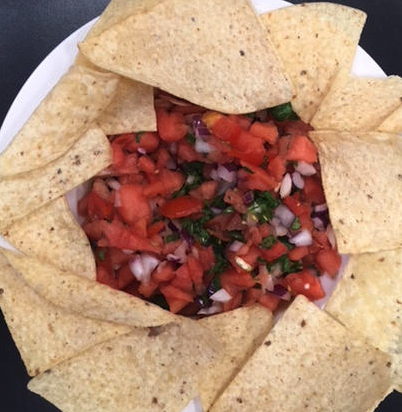
When The Washington Post was considering doing a feature story about my book, Diet Simple, among the recipes they tested was my chili. They loved it! The whole-front-page “Food” section feature was written. No one would ever guess my chili is healthy. That’s why I call it “stealthy healthy!”
Katherine’s Chili Non-Carne
(excerpted from Diet Simple: 195 Mental Tricks, Substitutions, Habits & Inspirations (LifeLine Press)
Try making this recipe a day ahead of time so the flavors and textures have a time to develop. I love this simple, quick chili recipe. It’s meatless but you don’t miss the meat because it’s so flavorful and the meat-like texture is deceptive. You should use the amount of garlic or chili powder that appeals to you. I like it hot and spicy! I double the recipe, using a whole pound of dried black beans, so I have plenty for the week. I use this dish as a lunch or dinner alongside a green salad. I also serve it at parties as a dip next to my fresh tomato salsa, nonfat Greek yogurt, and guacamole. It’s perfect rolled up in a tortilla or stuffed in a taco with some reduced fat cheese.
Serves 4 as a main course, 8 or more as a dip or topping
1/2 Cup Water (To Hydrate the Bulgur)
1/2 Cup Bulgur (Cracked Wheat)
1 Tbsp Olive or Canola Oil, or more
1 Large Onion, Chopped
3 Large Garlic Cloves, Minced (more or less)
3 Tbsp Hot Chile Powder (try 50/50 Chipotle Chili, maybe a dash of smoked paprika, called “Pimentón,” and just a pinch of Cinnamon)
1 Large Fresh Green Pepper, Chopped
1 28- oz. Can Italian Plum Tomatoes, chopped, including the liquid
1 Pound Can Kidney or Black Beans, whichever is preferred
2 Seeded Jalapeño Peppers, chopped, if desired
Salt and Pepper to Taste
Place the bulgur in a microwavable bowl. Add the boiled water. Place in microwave for 3 minutes. Keep in the microwave while it fluffs up. Meanwhile, sauté the vegetables.
Sauté the onions and garlic in the oil over low heat in a large pot until soft, 15 or more minutes. Add the chili powder and simmer for a few more minutes. Add the Fresh Green Pepper and cook until al dente. Add all remaining ingredients including the bulgur and simmer slowly over low to medium heat until flavors are well blended and vegetables are cooked to the desired consistency … a few minutes or longer, if desired. Adjust seasonings to your preference. Since many canned items were used, additional salt will probably not be needed.
Calories per serving 320, Total Fat 7g, Saturated Fat 1g, Carbohydrate 59g, Fiber 13g, Protein 12g
Katherine’s Spicy Fresh Mexican Salsa with Mild Guacamole
(excerpted from Diet Simple: 195 Mental Tricks, Substitutions, Habits & Inspirations (LifeLine Press)
Fresh salsa – Pico de Gallo – doesn’t really need a recipe. These are proportions I have found pleasing. But you may want your salsa, with more or less onions, more spice, sweeter (add watermelon), parsley instead of cilantro… The options are endless.
22 servings
Ingredients
1 large onion, peeled and chopped (about ½ pound)
2 lbs fresh tomatoes, peeled, seeded and chopped (start with about 3-1/2 lbs) (Use canned tomatoes, if good tomatoes aren’t available)
3 – 4 jalapeño peppers (1 – 2 ounces), to taste
¼ cup chopped fresh cilantro
½ tsp salt, or to taste
3 – 4 Tbsp fresh lime juice or the juice from 1 – 2 limes (optional. I often skip the limes)
Add the onion to the tomatoes. Finely chop 2 of the jalapeño peppers to start with. Taste. If you desire more heat, add 1 – 2 more jalapeños. Mix in the cilantro. Add the salt depending on your taste. Mix in the lime juice.
20 calories, 0g fat, 5g carb, 1g fiber, 1g protein
Katherine’s Guacamole
There a a million recipes for Guacamole. You can keep it mild, or make it hot by adding hot peppers. Throwing in fresh salsa makes it chunky and yummy, too.
12 Servings
Ingredients
2 ripe avocados
1/3 cup chopped fresh cilantro
2 Tbsp lime juice
¼ tsp salt, or to taste
freshly ground black pepper, to taste
Cut avocados in half lengthwise and pull out the pits. Scoop out the meat. Place ina medium bowl and mash, keeping some large chunks. Mix in the cilantro, lime juice, salt and pepper. Taste to adjust seasoning.
50 calories, 5g fat, 1g sat fat, 3g carbs, 2g fiber, 1g protein
7 Steps For Realistic, Achievable New Year’s Resolutions: A Second Chance!
- At January 20, 2019
- By Katherine
- In Articles, News
 0
0
The new year is a valuable opportunity to improve the quality of your life and happiness… Lose weight, eat healthfully, exercise… But most of us make impossible new year’s resolutions, and have given up by now. Does that describe you?
Don’t get me wrong. Resolutions are good. For instance, losing weight, eating more healthfully, being more physically active, are often essential life goals leading to increased energy, health and happiness.
But “losing weight” – or achieving any goal – means nothing without deciding on shrewd, small, concrete changes which can easily be incorporated into your daily routine. Look for approaches that complement, not dominate, your life.
Setting Goals, Keeping Goals
excerpted from “Diet Simple”
I can’t stress enough that goals should be fun and liberating, not just another ball and chain that weighs you down and reminds you of your failures. (We all have them, believe me!)
Everyone’s goals are different, of course. I don’t presume to have a one-size-fits-all set of goals that works for everyone. Over the years, however, I have developed some goal-setting strategies that I think will make a real difference.
For success, your goals should be:
Realistic. Perfectionistic goals set you up for failure.
Small, behavioral steps. You can’t set a goal of losing 2 pounds, but you can set a goal of doing the things that will cause you to lose 2 pounds. For instance, bringing a yogurt snack to work or adding delicious vegetable dishes to lunch and dinner.
Positive. Instead of stating what you won’t do (“I’ve got to stop eating chips every night”), state what you will do (“I’ll prepare a delicious fruit salad to snack on in the evenings”).
Flexible. Setting a goal to “exercise every day” may not be possible because of unforeseen circumstances. But saying instead, “I will be physically active 5 out of 7 days,” or “I will increase my daily pedometer steps by 2,000 this week,” is certainly do-able.
Measurable. “I’ll eat more fruits and vegetables,” is a noble goal, but how will you know when you reach it? Give yourself specific criteria so you can reward yourself for a job well done. “I’ll make a delicious vegetable batch recipe this weekend,” or “I’ll add a vegetable soup or salad to lunches this week.”
Important to you. Your goal must come from your heart, not your spouse’s or parent’s.
In a supportive environment. Does your home and work environment make healthful behaviors easier or harder? Do you need to have healthful, tasty, ready-to-grab foods in your refrigerator? Do you need your spouse to participate more fully with your healthy lifestyle? Take a look at your environment to determine if it is supportive enough and you have the tools you need to achieve your goals.
The battle of the bulge will be won at the margins. Sweeping changes are impractical and won’t work!
This article is excerpted from my book, “Diet Simple.”
Anti-Sugar Extremists Take the Joy – and Health – Out of Living
- At January 19, 2019
- By Katherine
- In Articles, News
 0
0

One of my favorite meals: peanut butter and jam on a toasted english muffin. Take that, sugar shamers!
I think most of us agree that extremism is, well, extreme! For most of you, extremism in politics or religion may first come to mind. But zealotry takes many forms and can hurt you in even worse, and more personal, ways when it comes to your health.
In the nutrition and food world, fanatics are far and wide, pronouncing this or that food as the death of us all, and others as saviors. Today, sugar is the demon. People exhaust themselves looking obsessively for grams of sugar on labels or on the internet.
I see too often, a look of shame when someone sheepishly “confesses” to eating a piece of chocolate or candy, a slice of birthday cake, ketchup, “too much” fruit, carrots, an ice cream cone when out with their kids, a latté, orange juice at breakfast, fruited yogurt, and more.
I mean, really, could bananas, carrots, or fruited yogurt be the cause of the world’s obesity epidemic? Or, more importantly, the cause of your weight problem?
Obviously, I jest. But many people are so misguided that they avoid essential sugar-containing foods. My heart goes out to them!
When health officials warn against too much sugar in the American diet, they’re not referring to fruit, 4 or 6 ounces of fruit juice daily, or yogurt – even if there is a tablespoon of jam on the bottom. They’re not referring to the occasional treat.
There is no scientific evidence that sugar in moderation, when included in an overall healthful diet, is harmful, except maybe if you don’t brush your teeth!
I am Grateful for My Neighbors Who Helped Me During the Snowstorm… Please Help Your Neighbors!
- At January 14, 2019
- By Katherine
- In Articles, News
 0
0

My angels – my neighbors – shoveled my stoop and walkway in front of my house. It helped me immensely. I feel so grateful for them!
My neighbors are angels. They shoveled me out of my home and cleared the “igloo” atop my car so that I could drive to the Salvation Army. The people there, recovering from drug and alcohol addictions, need me. I feel so much joy helping them. Some of you may already know that I teach them how to take care of their nutrition, health and wellness, so that they have a better chance of living healthfully during and after their recovery. And, perhaps, they may even have a better chance of recovering. I feel appreciated there. My colleagues, who work there 24/7 do much more than I.
So many people in your neighborhood need help getting around during emergencies. They may need to get to a grocery store, the hospital, their pharmacy. They may need water or shelter. But many of them will be too proud to ask.
I’m lucky that my neighbors know that I’m using crutches at the moment because of a sprained leg, and they help, whether I ask or not.
My guess is most of you do help people in need. I’m so grateful that my neighbors are among the angels in this world.
Should You “Detox”? A Few of My Intermittent Dieting Strategies
- At January 14, 2019
- By Katherine
- In Articles, News
 0
0
Should you “detox?” Did you gain weight last year? After your vacation or a business trip? Have you made a New Year’s Resolution to lose weight? Or have you given up on those resolutions? No need to give up! There are so many ways to lose weight quickly, most are unhealthy or backfire.
Intermittent dieting is in the news a lot! But be sure you are doing it in a way that is PERSONALIZED for you. That way it is enjoyable! And more likely to last. You can use your favorite strategy to lose weight but also to maintain it. That’s why finding a sustainable approach – one that is perfect for you, your lifestyle, your likes and dislikes – is critical.
I’ve found a way to lose weight fast that is satisfying, increases your energy and confidence, allows you to eat your favorite foods, is sustainable, good for you…and, most importantly, works like a charm! I call it my “Diet Simple Detox.” In fact, I’m doing my detox program now after some holiday weight gain.
One UNsuccessful way of Intermittent Dieting is fasting at breakfast and/or lunch. That usually backfires by causing craving and overeating as the day goes by, which is the opposite of what you need for weight loss.
Intermittent dieting is an approach that doesn’t need to be followed exactly how you might have read about it somewhere. Or in a way that someone you know is doing it. It absolutely can be personalized to your own needs and specifications!
I always give my clients the option and we decide the best way to go about it together. One of the most successful ways is to “semi-fast” in the evening (no need to be restrictive earlier in the day). The way I recommend doing it is to eat about 2/3 or 3/4 of your calorie needs before the evening and then skip dinner, or stick with something very low calorie such as a veggies, yogurt and/or fruit, a salad or soup. The two nights of semi-fasting allow you to eat more enjoyably overall, it can undo damage done during the week, and … surprise … it’s even healthy and enhances your energy.**
There have been numerous studies establishing that eating more during the day and less at night is more likely to aid weight loss. This confirms my observations and recommendations of the last 30 years (Ha Ha! I know, I’m a genius).
The key to quick weight loss and a successful semi-fast is to find two nights when semi-fasting would be easier for you. One of my clients semi-fasts on nights her husband is traveling, when she isn’t faced with eating a full meal with him; she has a satisfying veggie-centric soup. Another client simply doesn’t eat Monday and Tuesday nights (I couldn’t do it!). She lost 35 pounds before her wedding and has kept it off. A client who is a professor has two days when he teaches for ten hours. He gets home exhausted and has found he doesn’t need dinner those nights.
I personally have used this strategy most of my adult life, before knowing about the studies. My motto since the 1980s has been “Light at Night,” and it works. I generally eat light at night for weight maintenance and I’m doing my “Diet Simple Detox” now – after gaining some holiday pounds.
You could lose two to three pounds a week with my “Diet Simple Detox”!
** A growing body of evidence shows calorie restricting may reduce disease and extend life. There are many theories to explain this and one is that a lower metabolism causes less oxidation, cell proliferation (cancer), and decreases harmful chemicals and hormones in your body.

